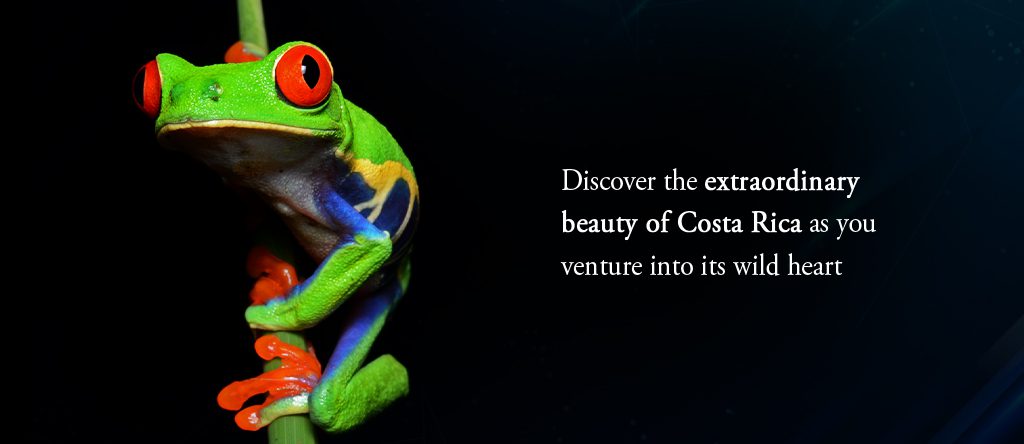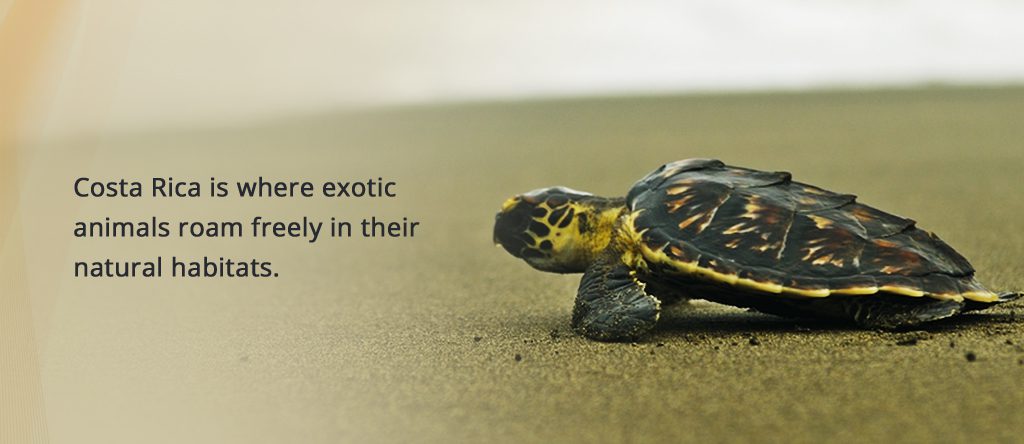What’s more breathtaking than being in the midst of untamed nature? Imagine lush rainforests, magnificent creatures, and exotic animals in their natural habitats. Costa Rica, a country teeming with biodiversity and ecological wonders, offers nature enthusiasts a unique experience. It boasts 5% of the world’s biodiversity, making it a dream destination for nature enthusiasts. This blog aims to take you on a captivating journey through the exotic wildlife in Costa Rica.
The Breathtaking Biodiversity of Costa Rica
Costa Rica, a tiny gem in Central America, holds a staggering wealth of biodiversity that continues to astonish scientists and nature lovers. The exotic diversity of flora and fauna in Costa Rica will leave you in awe, from the tiniest insects to the magnificent mammals.
The secret behind this astonishing diversity of exotic animals here lies in the diverse ecosystems. The landscapes vary from dense rainforests, misty cloud forests, lush mangroves, and sun-kissed coastal regions. Towering trees form a canopy that shelters countless creatures while the forest floor teems with life, from tiny leaf-cutter ants to stealthy jaguars. Each habitat harbors unique flora and fauna, creating a paradise of ecological wonders.

Iconic Wildlife Species Exclusive to Costa Rica
The biodiverse landscapes here are rich in variety and home to iconic animal species found nowhere else. These unique creatures have adapted to the country’s diverse habitats, creating a remarkable experience for wildlife enthusiasts.
1 – The Harlequin Tegu
Harlequin Tegu is a striking lizard species known for its distinctive black and white pattern on its body. Its name, “Harlequin,” comes from the unique, diamond-shaped pattern of black and white scales that covers its back and sides. This intricate and eye-catching pattern gives the tegu a striking appearance, making it stand out in its natural habitat.
You can spot the Harlequin Tegu in various habitats, including savannas, grasslands, and lowland forests of South America. Their versatility in habitat preference allows them to thrive in diverse landscapes, ranging from open grassy plains to dense, lush forests.
As omnivores, Harlequin Tegus have a varied diet, consuming animal and plant matter. Their menu includes insects, small vertebrates, eggs, fruits, and vegetation. They are diurnal creatures, meaning they are most active during the day, giving them a wider window for hunting and foraging.
2 – Red-eyed Tree Frog
The Red-eyed Tree Frog (Agalychnis Callidryas) is one of the most exotic animals found in this country. Instantly recognizable, this small amphibian boasts striking colors and large, bulging, bright-red eyes that seem to stare directly into your soul.
Beyond their captivating appearance and ecological role, the Red-eyed Tree Frog holds cultural significance in folklore. The frog connects with rain and fertility in Central America’s indigenous cultures. Its rhythmic call, heard during the rainy season, is believed to summon the rains that nurture the land and promote growth.
For nature enthusiasts and eco-tourists visiting this Central American country, spotting a Red-eyed Tree Frog in the wild is an unforgettable experience. Tour guides often lead night hikes to spot and enjoy these enchanting creatures up close, fostering a deeply rooted connection between humans and the natural wonders. These night rendezvous are arguably one of the best places to enjoy hiking in Costa Rica.
3 – Central American Tapir
The Central American Tapir, also known as Baird’s Tapir (Tapirus Bairdii), is a magnificent and enigmatic creature that resembles a large, pig-like mammal. Despite its stocky appearance, the tapir has a fascinating evolutionary history that traces back millions of years, making it one of Earth’s oldest surviving land mammals.
As an essential herbivore in the ecosystem, the Central American Tapir plays a crucial role in seed dispersal and plant regeneration. With its foraging behavior and diverse diet, including fruits, leaves, and tender shoots, the tapir ingests various seeds from various plant species. After digestion, the tapir excretes these seeds in different locations, helping to spread and distribute seeds throughout the forest.
Beyond its ecological significance, the Central American Tapir holds cultural value. Some indigenous cultures consider the tapir a symbol of strength, resilience, and harmony with nature.
4 – Mantled Howler Monkey
The Mantled Howler Monkey is a beautiful exotic animal in Costa Rica, with its striking black and brown fur adding an air of mystery to the dense tropical rainforests it calls home.
The Mantled Howler Monkeys prefer to live in tall trees within tropical rainforests. These dense, lush canopies offer them shelter and an abundant supply of their favorite food – leaves. They are highly adapted to an arboreal lifestyle, using their prehensile solid tails to navigate the treetops effortlessly and to hang from branches while they munch on leaves.
This stunning country is ideal for spotting this mesmerizing creature. The country’s extensive rainforests and protected areas offer a haven for these monkeys to thrive. Seeing a troop of Mantled Howler Monkeys in their natural habitat is an experience like no other. Their playful antics, heartwarming family dynamics, and soul-stirring howls will leave you in awe of the wonders of the rainforest, making wildlife watching an interesting thing to do on the Pacific Coast of Costa Rica.
5 – Green Sea Turtle
The Green Sea Turtle, scientifically known as Chelonia mydas, is a captivating animal admired for its stunning characteristics and innate charm. These elegant turtles have won people’s hearts worldwide. One of the most enchanting features of the Green Sea Turtle is its attractive greenish skin and shell, which sparkles like emeralds under the sunlight. Their scales’ vibrant colors and patterns make them a true spectacle to behold. Their beauty leaves observers in awe as they glide effortlessly through the crystal-clear waters.
This Central American gem is fortunate to have several nesting sites where Green Sea Turtles come ashore to lay their eggs. Nestled on the Caribbean coast, Tortuguero National Park stands as one of the most vital nesting areas worldwide. During the nesting season, i.e., from July to October, many Green Sea Turtles visit the sandy beaches of Tortuguero to lay their eggs.

Wildlife Sanctuaries and National Parks in Costa Rica
This country is a treasure trove of diverse biodiversity, offering an immersive and unforgettable experience for nature lovers seeking to connect with the natural wonders. This country showcases its commitment to preserving its natural heritage in these remarkable wildlife sanctuaries and national parks.
Let’s look at some of the best places to enjoy the exotic and rare diversity of fauna.
1 – Corcovado National Park
Known as the “crown jewel” of Costa Rica’s national park system, Corcovado is a true wilderness wonderland. Situated on the Osa Peninsula, it has an astonishing diversity of fauna, including all four monkey species, scarlet macaws, tapirs, jaguars, and giant anteaters.
2 – Tortuguero National Park
Nestled on the Caribbean coast, Tortuguero is a crucial nesting site for endangered Green Sea Turtles. From July to October, visitors can witness the incredible arribada, where thousands of turtles lay their eggs in synchronized mass nesting events. The park’s intricate network of canals and waterways is teeming with caimans, river otters, and diverse bird species in Costa Rica, making it a paradise for wildlife lovers and birdwatching enthusiasts.
3 – Manuel Antonio National Park
The park’s hiking trails offer a chance to observe the fascinating behaviors of some unique creatures up close. Its white sandy beaches, lush rainforests, and clear turquoise waters create a stunning backdrop for faunal diversity sightings. Capuchin monkeys and three-toed sloths are commonly spotted in Manuel Antonio National Park, along with colorful poison dart frogs and an array of tropical birds.
4 – Monteverde Cloud Forest Reserve
Perched high in the Tilarán Mountains, Monteverde is a misty and ethereal cloud forest. It is famous for its diverse birdlife, including the Resplendent Quetzal, and unique mammals like the enigmatic ocelot and the adorable kinkajou.
5 – La Amistad International Park
Spanning across the country and Panama, La Amistad is a UNESCO World Heritage Site and one of the best places to enjoy wildlife watching. Its vast and rugged terrain supports a rich tapestry of ecosystems, from lowland rainforests to highland cloud forests. Here, you can encounter elusive creatures like the Baird’s Tapir and the elusive Harpy Eagle.
Tips for Wildlife Tours in Costa Rica
- Choose Certified Tour Operators: Select tours run by reputable, certified operators focusing on responsible, sustainable, eco-tourism and wildlife conservation.
- Use Local Guides: Choose local guides with deep knowledge of the region’s wildlife, ecology, and conservation practices.
- Opt for Small Groups: Join tours with small group sizes to minimize the impact on wildlife and enhance your experience.
- Support Conservation Efforts: Choose tours contributing to wildlife conservation and community-based initiatives, ensuring your visit benefits the local communities.
Ethical Wildlife Photography and Observing Tips
When engaging in wildlife photography in Costa Rica, it is essential to follow ethical guidelines to ensure the animals’ safety and welfare and preserve their natural habitats. Participating in responsible tours should be in your Costa Rica vacation itinerary.
Let’s look at some tips to observe and photograph animals responsibly.
- Always keep a safe and respectful distance from the animals. Getting too close can stress them and disrupt their natural behavior.
- Opt for cameras with silent shutter modes and avoid using flashes, which can startle or disturb the animals.
- Stick to designated paths and trails to minimize habitat disturbance and avoid trampling sensitive vegetation.
- Speak in low tones and avoid sudden movements to prevent startling the animals or alerting potential predators.
- Allow animals to approach you if they choose to but avoid walking to them aggressively or blocking their paths.
- Never surround or corner animals; it can lead to stress and defensive behavior.
- Some areas may be off-limits to protect nesting sites or sensitive habitats. Respect these restrictions for the welfare of wildlife in Costa Rica.
Responsible and sustainable eco-tourism is more than just admiring faunal diversity; it is about positively impacting the environment and conserving wildlife.

Conclusion
The exotic wildlife in Costa Rica connects us profoundly with the natural world, inspiring wonder and awe. Let us cherish every moment spent in the company of these remarkable creatures while ensuring we leave nothing but footprints. We can create a harmonious and sustainable future where humans, flora, and fauna coexist harmoniously, ensuring these precious landscapes’ legacy for eternity.











